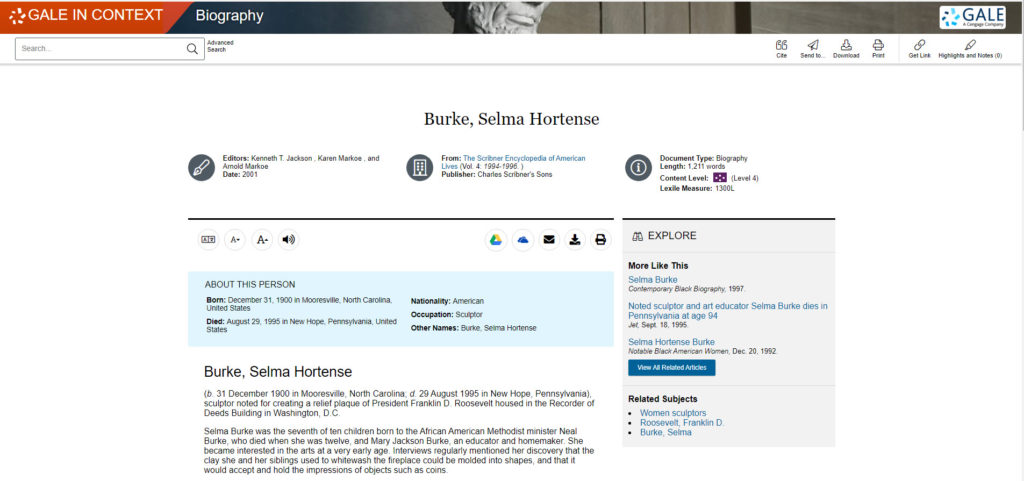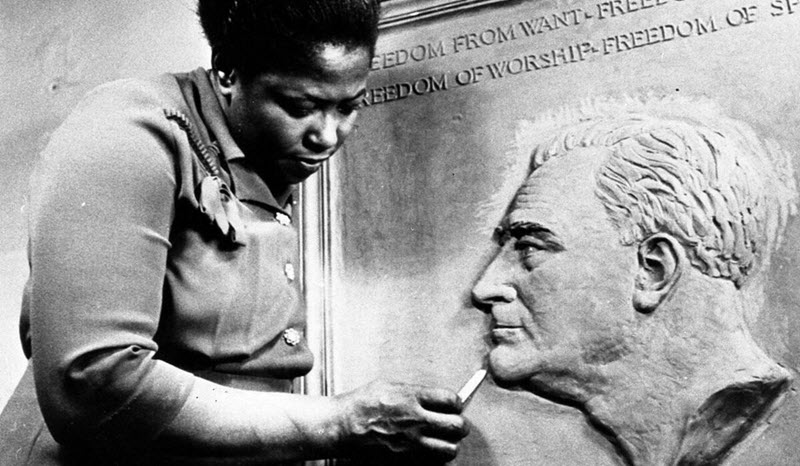| By Shirelle Phelps |
Every day we look at the coins in our purses, pockets, and wallets and never really think much about the artists who created the images on them. The dime is no different—or is it?
The dime is the smallest coin in U.S. circulation, but if you look closely, you’ll see the initials “JS” just beneath Franklin D. Roosevelt’s neck. The initials belong to John Sinnock, the U.S. Mint’s chief engraver from 1925 to 1947, who is credited with sculpting the profile of FDR, the 32nd president of the United States. However, many credit Selma Burke for the design, including Roosevelt’s son and the Smithsonian American Art Museum. Burke’s portrait, which she spent two years working on, is only recognized as an inspiration and model for the final image used on the dime.
Selma Hortense Burke is a Black American sculptor who was born on December 31, 1900, in Mooresville, North Carolina. She grew up in a large family, the seventh of 10 children of Rev. Neil and Mary Elizabeth Colfield Burke. As a child, she often played with riverbed clay near her home and loved how the clay felt. Inspired by her maternal grandmother, who was a painter, Burke’s adoration of sculpture grew. As an adult, she earned several degrees and awards, and traveled internationally, studying in France, Germany, and Austria. While in Paris, Burke worked under Henri Matisse, whom she credits as one of her many influences. When she returned to the States due to the threat of Nazis, she created the image of FDR that’s engraved on the U.S. dime.

In 1943, Burke won a Commission of Fine Arts competition and a rare opportunity to sculpt the president’s likeness for the new Recorder of Deeds Building in Washington, D.C. While creating the image of FDR, she found it challenging, so she wrote to the White House to request a live sketch session. To her surprise, they agreed. In February 1944, Burke met with Roosevelt and sketched his profile on a brown paper bag. He invited her back for another session the following day. About a year later, just months before the president’s death, Eleanor Roosevelt visited Burke’s home in New York to see the final draft. Mrs. Roosevelt didn’t believe it represented him well because she thought FDR looked too young. Burke responded, “I didn’t make it for today, I made it for tomorrow and tomorrow.”
Unfortunately, President Roosevelt died before the official unveiling of the plaque. To commemorate his legacy and his founding of the March of Dimes, the U.S. Mint and Congress proposed engraving FDR’s portrait on the dime. John Sinnock was chosen to sculpt the image, as he had experience sculpting presidents in profile while teaching at the Pennsylvania Museum School of Industrial Art. Sinnock also worked at the Philadelphia Mint as an assistant engraver. There, he designed presidential medals for Calvin Coolidge and Herbert Hoover, and later Roosevelt’s third inaugural presidential medal. Sinnock’s dime was released to the public on January 30, 1946, which would have been Roosevelt’s 64th birthday, but not without controversy.
The most vocal critic of the dime was Selma Burke. She claimed it bore a striking resemblance to her portrait, and many others agreed. However, when Burke demanded an investigation into Sinnock, she said the FBI investigated her instead. Sinnock denied Burke’s accusations, and died just a year after the coin was issued. Years later, debate among numismatists (those who study coins, paper currency, and medals) continues. Some credit Burke unequivocally, while others have conducted side-by-side comparisons to suggest significant differences between the sculptures, particularly with Roosevelt’s nose and hair.
After the U.S. Mint officials gave credit to Sinnock for the dime, Burke continued sculpting. She also founded the Selma Burke School of Sculpture in New York, the Selma Burke Art Center in Pittsburgh, and was honored by President Jimmy Carter with the Women’s Caucus for Art Lifetime Achievement Award in 1979. Even without credit for the dime, Burke was great in her own right. She died in 1995 at the age of 94.
As you reexamine the dime in your pocket, learn more about Selma Burke and many more amazing people in Gale In Context: Biography and explore!
To expand support for Black History Month further, check out these eBook titles, all available on the award-winning Gale eBooks platform.

Meet the Author
Shirelle Phelps is a director of Content Strategy and Development for Gale products that highlight biographies, film, law, automotive (Chilton), science, and health content. She enjoys vacationing in the West with her family and taking bike riding adventures with her husband.
new nike football boots 2012 2017 – 002 – Nike Air Max 270 ESS Ανδρικά Παπούτσια Γκρι / Λευκό DM2462 | nike roshe runs grey and pink shoes blue suit – 100 – Cheap Nike Zoom Pegasus 38 White/Black – Pink Blast DJ5397

